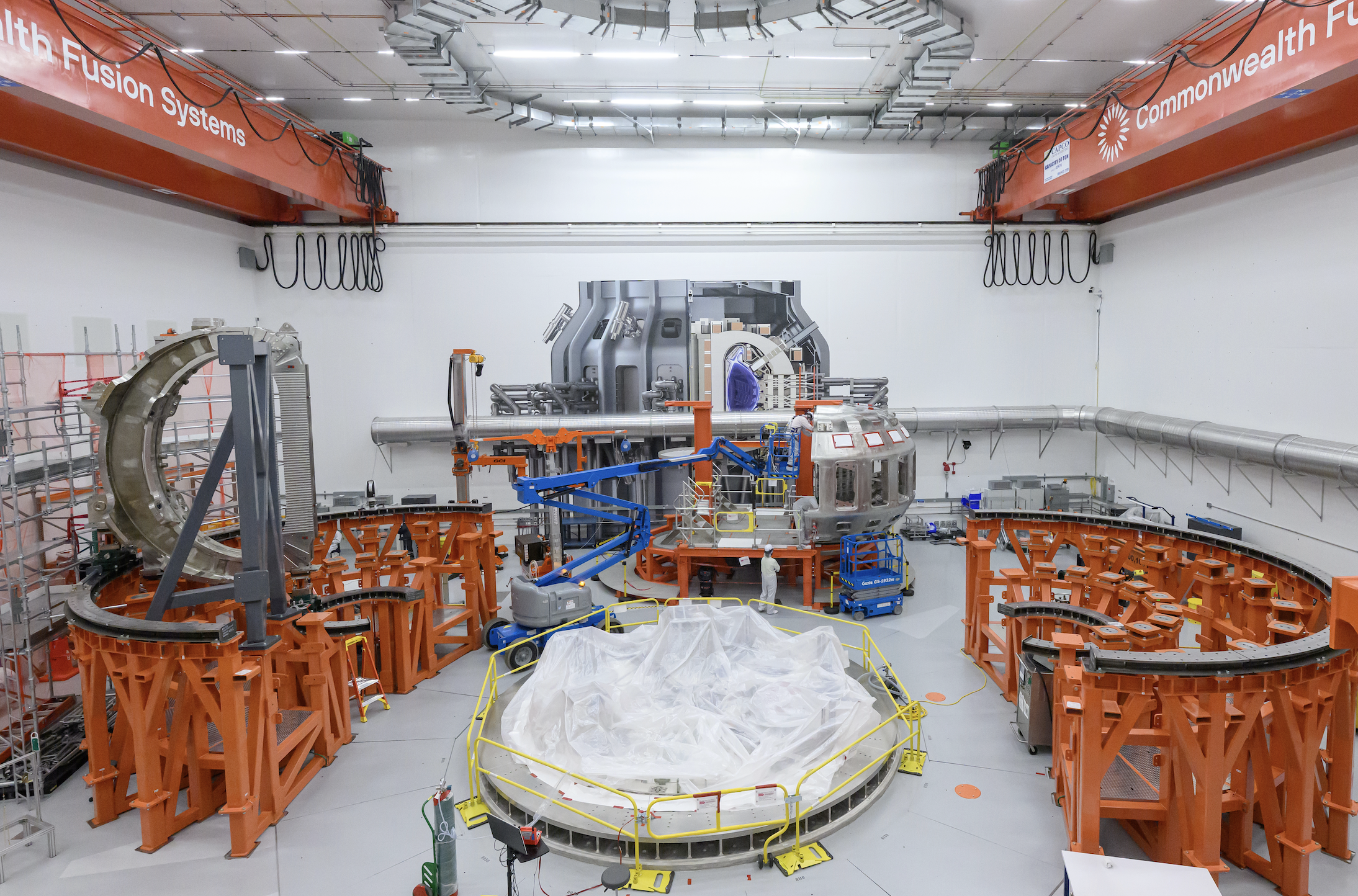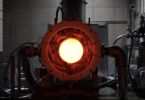The global pursuit of fusion energy –which has great potential as a safe, abundant, zero-carbon source of reliable electricity and is recognized as a potential game-changer in addressing climate change and rising global energy demand – has entered a decisive new phase, according to an October report by the International Atomic Energy Agency.
A clear illustration of that is the U.S. Department of Energy’s (DoE’s) new fusion roadmap, which was published October 16 and outlines how it expects the technology to become a part of the country’s energy mix by the early 2030s. “Fusion is real, near, and ready for coordinated action,” Jean Paul Allain, Associate Director of DoE’s Office of Fusion Energy Sciences, said in a statement.
AI could help turn that goal into a reality.
On the same day that the DoE announced the U.S.’s national strategy to accelerate the development and commercialization of fusion energy DeepMind and Commonwealth Fusion Systems (CFS), a U.S. fusion energy company that has raised over $3 billion in funding, announced a research partnership to help accelerate the timeline to deliver fusion energy to the grid.
“The combination of our AI expertise with CFS’s cutting-edge hardware makes this the ideal partnership to advance foundational discoveries in fusion energy for the benefit of the worldwide research community, and ultimately, the whole world,” Google DeepMind said in a blog posting.
DoE Secretary Chris Wright underscored the role AI is set to play in advancing the fundamental science required to scale fusion energy production. “It’s hard to overstate the catalytic effect of artificial intelligence,” he was quoted as saying during an October 14 event, noting that AI’s data processing power can support advancements in materials science, digital modeling of the sun’s own fusion energy production and molecular dynamics.
The Global Race To Realize Fusion’s Promise
Fusion, the process that powers the sun and stars, could provide a nearly limitless source of energy without producing harmful carbon emissions or long-lived waste. The world’s first commercial facility would mark the dawn of a new era of energy.
The promise has excited scientists since the 1950s. The holy grail – the ability to produce more fusion energy than is needed to create it- has remained elusive but it is getting closer and is projected to play a significant role in meeting the world’s growing demand for clean, baseload power
It’s not surprise then that fusion energy will be a key topic at Science House, a gathering place for Nobel laureates, pioneering researchers, policymakers, business leaders, and philanthropists to convene for debates and strategic roundtables organized by the open science publisher Frontiers during the World Economic Forum’s annual meeting in Davos January 19-23. (The Innovator is a media partner of Science House and The Innovator’s Editor-in-Chief will be a journalist in residence and a moderator there)
Fusion — which occurs when hydrogen isotopes are heated to such extreme temperatures that they fuse and release energy — is advancing through multiple parallel efforts.
A total of 33 nations and thousands of engineers and scientists have been collaborating since the 1980s to build and operate a magnetic fusion device called a tokamak in a project called ITER, ITER, the world’s largest fusion experiment, is designed to prove the feasibility of fusion as a large scale carbon-free source of energy. The project is helping fill in some of the gaps in understanding needed to develop the science commercially and importantly is constructing the necessary supply chain, says Enrique Garcia, Head of Fusion Technologies & Engineering at Fusion for Energy, a European Commission initiative tasked with designing systems and components for ITER.
At the same time, governments, private industry, and utilities are rolling out complementary initiatives that expand the global fusion landscape. There are at least 45 companies working to commercialize fusion energy around the world and the IAEA reports that more than 160 fusion facilities are now operational, under construction or planned.
Private-public initiatives are gaining momentum, and regulators are developing bespoke frameworks to keep pace, Meanwhile, end users such as Google, global energy company Eni and Microsoft are signaling growing confidence in the technology through early power purchase agreements.
One of the clearest signs that fusion is moving from a scientific experiment to a commercial reality is that the IAEA World Fusion Outlook 2025 for the first time includes global modelling of fusion energy deployment. Conducted by the Massachusetts Institute of Technology (MIT), the study, which was released October 25, explores how fusion could contribute to the future electricity mix under diverse policy, cost and technological assumptions.
In the lowest capital cost scenario of US $2.8K/kW in 2050, fusion’s share of electricity generation could reach up to 50% by 2100. Even in the highest cost scenario of US $11.3K/kW, fusion energy is projected to reach 10% of global electricity generation by 2100.
The modelling also highlights fusion’s economic value: with a rise in demand for clean electricity generation, fusion could add trillions of dollars to global GDP, according to the IAEA.
Governments see fusion energy as being strategic, just like technologies such as AI and quantum computing, so the race is on to see who will get there first.
EconSight, a Swiss company that tracks technology trends and patents, published a report on Ocotober 24 on China’s technology focus in its new five-year plan 2026-2030. Fusion Energy is number one on China’s list and EconSight shows that is far ahead of both Europe and the U.S., filing 67% of world class patents in fusion energy compared to 19% for the U.S. and 5% from Europe.
Sam Guilaume, CEO of France’s Renaissance Fusion, recently attended a fusion energy October conference in Changdu, China and made stopovers in Seoul, Tokyo and Singapore to explore areas of collaboration with researchers. His key takeaways? “China doesn’t need us” and AI is now seen as a key accelerator of fusion energy. “There is a frenzy around AI and a growing belief that we have to use it to advance plasma physics,” he says.
Controlling the plasma, within a magnetic confinement fusion is challenging due to the need to confine and maintain the hot and dense plasma in a stable, defined volume for a prolonged duration. Plasma is highly unstable and extremely sensitive; industry experts say it’s like trying to hold jelly with rubber bands. The immense heat and pressure cause it to constantly want to expand and touch the container walls, which would instantly cool it down and stop the fusion reaction.
The main control challenges are:
• Magnetohydrodynamic (MHD) Instabilities: The extreme energy and internal currents of the plasma drive macroscopic instabilities that threaten to quickly extinguish the fusion reaction.
• Turbulence and Transport: Microscopic fluctuations in plasma density and temperature gradients cause particles and heat to escape the core causing the plasma to cool down and requiring active heating to sustain the required fusion temperature.
• Heat Exhaust and Wall Interactions: The plasma edge must be managed to safely remove excess heat and spent fuel (helium ash) without having the material from the first wall feed into the plasma which would lead to a cooldown and stop the fusion reactions.
How AI Might Help
GoogleDeepMind and CFS’s partnership builds on the tech company’s work using AI to successfully control a plasma. With academic partners at the Swiss Plasma Center at EPFL (École Polytechnique Fédérale de Lausanne), Google showed that deep reinforcement learning can control the magnets of a tokamak to stabilize complex plasma shapes. To cover a wider range of physics, Google DeepMind developed TORAX, a fast and differentiable plasma simulator.
Now, Google DeepMind says it is bringing that work to CFS to accelerate the timeline to deliver fusion energy to the grid. The two companies have been collaborating on three key areas so far:
- Producing a fast, accurate, differentiable simulation of a fusion plasma.
- Finding the most efficient and robust path to maximizing fusion energy.
- Using reinforcement learning to discover novel real-time control strategies.
The tokamak approach to fusion is the one that has been the most studied by scientists over the last 60 years. Tokamaks are essentially large magnetic donuts, designed to harness the energy of fusion; inside a tokamak, a fusion plasma is created and confined by strong magnetic fields. The energy produced through the fusion of atoms in the plasma is absorbed as heat in the walls of the vessel, or in the case of a power plant, by a liquid ‘blanket.’ Just like a conventional power plant, a fusion power plant will use this heat to produce steam and then electricity by way of turbines and generators.
Until now tokamaks had to be enormous in size to produce net energy from fusion. CFS is using high temperature superconducting magnets developed in collaboration with MIT to build smaller and lower-cost tokamak fusion systems. CFS is manufacturing these magnets and building what it calls the world’s first commercially-relevant net energy fusion machine, called SPARC, based on the tokamak approach.
Operating a tokamak involves countless choices in how to tune the various “knobs” available, like magnetic coil currents, fuel injection and heating power. Manually finding a tokamak’s optimal settings to produce the most energy, while staying within operating limits, can be very inefficient.
Using Google DeepMind’s TORAX in combination with reinforcement learning or evolutionary search approaches like AlphaEvolve AI agents can explore vast numbers of potential operating scenarios in simulation, rapidly identifying the most efficient and robust paths to generating net energy. “This can help CFS focus on the most promising strategies, increasing the probability of success from day one, even before SPARC is fully commissioned and operating at full power,” Google DeepMind said in a blog posting.
Google DeepMind said it is also developing an AI pilot that could control the magnetic configuration, maximize fusion power or manage SPARC’s heat load, so it can run at high performance with a greater margin to machine limits.
“We are working hard with Google DeepMind to use AI to advance the science and with Dominion Energy to build the first power plant to pull fusion energy into the future as fast as possible,” says Rick Needham, CSF’s Chief Commercial Officer.
CFS is on track to bring online its first grid-scale fusion commercial fusion power plant- called ARC- in Virginia in the early 2030s, says Needham. In the run-up to that CFS’ SPARC facility outside of Boston (see the photo) is expected to turn on and produce net energy gain in 2027, demonstrating for the first time a commercially relevant design that will produce more power than consumed. The ARC plant in Virginia is expected to produce 400 megawatts –enough energy to power large industrial sites or about 230,000 homes – the same as a typical natural gas plant. CFS expects to begin building the Virginia plant in 2028. It already has secured a conditional user permit and off-take agreements from Google and from global energy company Eni, with Eni’s offer alone valued at over $1 billion, says Needham. Both Google and Eni are also investors in CFS.
“Starting in the 2030s we are going to rapidly scale as quickly as possible,” he says. Since fusion has no materials limitations, Needham says CSF has the potential to build as many as 1000 plants a year by 2050.
CFS is competing with Helion, another fusion energy startup, to be the U.S.’s first commercial fusion power plant. Helion, which is backed by OpenAI’s Sam Altman, has announced that it will have a fusion power plant in operation by 2028. Microsoft has signed up as an off-take partner.
AI data centers being built by the U.S. hyperscalers are putting a huge strain on the energy grid, so they are keen to find a new source of renewable energy to power them.
Europe Is Playing Catch-Up
A range of other approaches such as stellarators, laser and inertial confinement concepts, magneto-inertial concepts, mirror machines, field reversed configurations, pinches and more, are being developed across public and private sectors, as the sector searches for pathways toward realizing fusion energy.
Trouble is there is not as much data about alternatives to tokamaks, making it more difficult to apply AI. As a result, France’s Renaissance Fusion, which is using a stellarator, another type of magnetic confinement device to achieve fusion, is looking for strategic partnerships to shore up its data, get access to models and find an AI partner, says CEO Guilaume, a speaker on a panel on an October 4 fusion energy at the Barcelona Deep Tech Summit moderated by The Innovator’s Editor-in-Chief.
To grow Renaissance Fusion, which has raised a total of €60 million, may have to look outside of Europe. Europe has poured billions into ITER, the global research project, but not as much into commercial fusion ventures.
Fusion startups in Europe such as Renaissance, Proxima, Novatron and Marvel Fusion have raised tens or hundreds of millions while U.S. commercial upstarts like Helion have raised $1 billion and CFS over $3 billion.
Marvel Fusion, which is based in Germany and working on laser-driven inertial fusion energy, has raised around €385 million in public and private funding. It is currently participating in the European Innovation Council accelerator program, which includes a €2.5 million grant and a €15 million investment. It has additionally received support from the German government through other programs. The company says it wanted to build its first prototype in Europe. “We carefully evaluated our option, and we found that the most cost-effective opportunity to leverage the construction of our technology demonstrator was with our partners in the U.S.,” says Mariana Martinez Pacheco, Strategy Manager at Marvel Fusion, who was also a speaker on the fusion energy panel at the Barcelona Deep Tech Summit.
In September Marvel Fusion announced that it had received a U.S. Department of Energy (DOE) INFUSE award for its proposal, “Nonlinear Effects in High-Intensity Laser Focusing in a Simulated Fusion Reactor Environment.” The award, in partnership with Colorado State University (CSU), will research in laser-plasma interactions, critical to advancing next-generation fusion energy systems. The project builds on Marvel Fusion’s expanding footprint in the United States, including its flagship partnership with CSU on a $150 million Advanced Technology Lasers for Applications and Science (ATLAS) facility, currently under construction in Fort Collins, Colorado. ATLAS is the largest collaboration of its kind between a private fusion company and a U.S. public institution, a strategic initiative designed to strengthen U.S. positioning in laser-based fusion energy research.
The DoE is further supporting the Colorado inertial fusion energy ecosystem through multiple initiatives, including the Inertial Fusion Science and Technology (RISE) Hub, led by CSU and Stanford University, and the Target Injector Nexus for Experimental Development (TINEX), part of the Fusion Innovative Research Engine (FIRE) program. Marvel Fusion is a contributor to both programs. The company is suggesting that European governments adopt similar funding strategies to those of the U.S., for example, milestone-based funding. “It is an important way to increase confidence,” she says.
Funding is not the only issue, says Renaissance’s Guilaume. The U.S. is working to streamline regulation so that fusion plants can be built as soon as possible but the same is not true in European countries. France, for example, plans to treat fusion in the same way that it legislates fission, even though the risks are not the same. Nuclear energy achieved through fission produces radioactive waste and poses dangers such as explosions. Fusion does not pose the same issues. Similar legislation could cause confusion in the mind of the public, creating delays in the construction of fusion plants, says Guillaume. The company is looking at Singapore and other places where conditions for growing a fusion energy company appear to be better.
Along with better funding for commercial projects and clear, consistent regulation of fusion energy across the Continent Europe needs to present a united front against giants like the U.S., says Martinez Pacheco.
The rest of the world isn’t waiting. “Fusion is coming faster than you think,” says CFS’s Needham. “Anyone who isn’t moving on it now is going to end up being the caboose.”
To read more of The Innovator’s Energy Transition stories click here.







